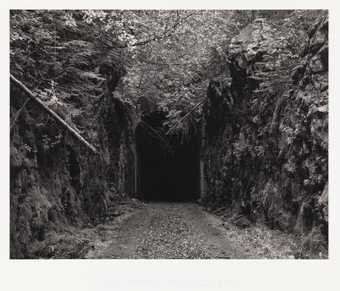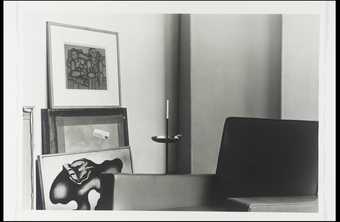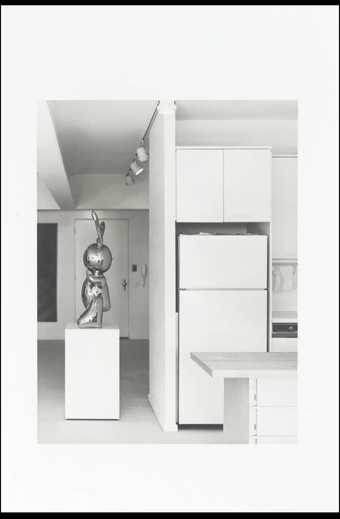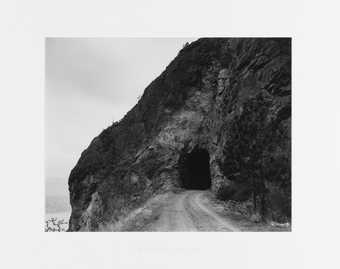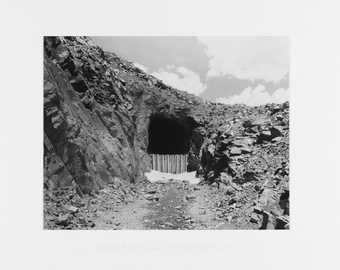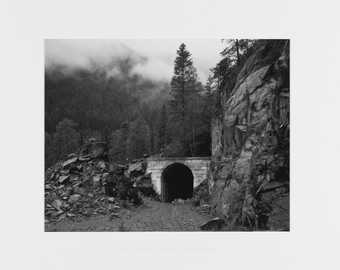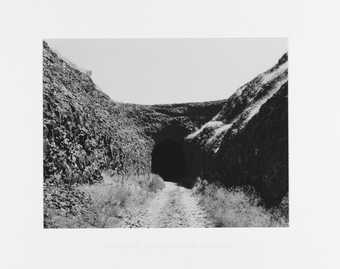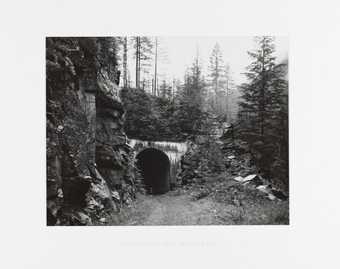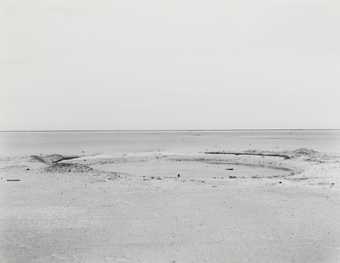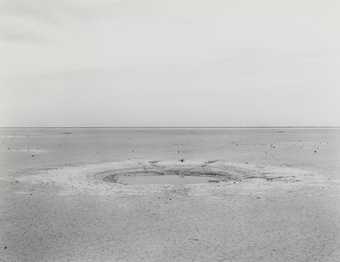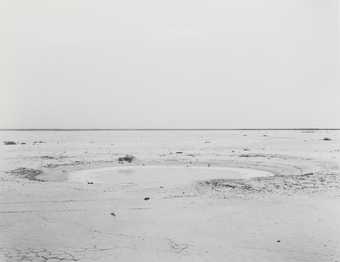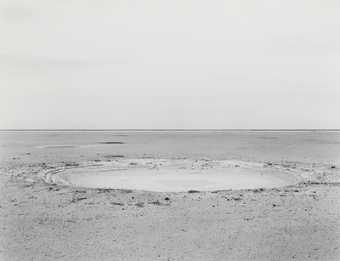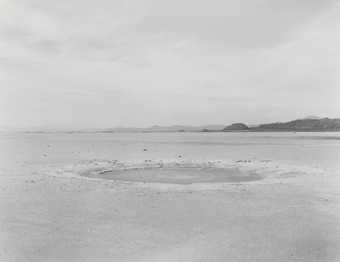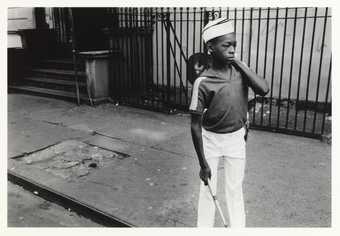
Not on display
- Artist
- Louise Lawler born 1947
- Medium
- Photograph, gelatin silver print on paper
- Dimensions
- Frame: 736 × 841 × 16 mm
mount: 380 × 554 mm - Collection
- Tate
- Acquisition
- Presented by the American Fund for the Tate Gallery, courtesy of the American Acquisitions Committee 2009
- Reference
- P79772
Summary
March 25, 1991 is a gelatin silver print showing a corner of a gallery space in the Whitney Museum of American Art during the installation of the 1991 Whitney Biennial. In the foreground two packing crates stand on a small sculptor’s trolley. Behind them, a painting of a domestic interior by American Pop artist, Roy Lichtenstein (1923-97), is propped against the wall. A narrow strip of another painting by the same artist is visible on the right side of Lawler’s image. The gallery has a highly polished floor, generating reflections of the paintings and the crates that repeat and intensify the imagery. Other installation detritus, such as the strips of foam that protect the edges of the paintings from the floor, is visible under the paintings and lying on the floor to the left of the packing cases. Lichtenstein’s painting, Interior with African Mask, 1991, dominates Lawler’s photograph. It shows a room in an affluent home in which modernist furniture is offset by vases of flowers and art objects of various sorts, including an African mask standing on shelves behind an elongated seat. In Lawler’s composition, the mask appears to be facing towards the wooden crates, setting up a play on the notion of importation (packing crates and exotic objects), materials (both are made of wood), value (artworks in museums and exotic objects in the home), ethnicity (white American artists showing in an American museum and African art in an American home) and geometric containment (the mask stands inside a rectangular space in the shelves that mirrors the rectangular volume enclosed by the crates).
Interior with African Mask is one of the series Interiors that Lichtenstein created in 1991. The painting displayed beside it, that is barely visible in Lawler’s photograph, is another from the same series, Interior with Mirrored Wall. Famous for bringing the imagery of comic strips into painting in the early 1960s, thereby deconstructing the clichés of contemporary culture and reworking them into high art, Lichtenstein continued to work with stylistic stereotypes in his work of the 1970s onwards. All his series of paintings analyse and utilise formal characteristics of such twentieth-century art movements as Cubism, Impressionism, Abstract Expressionism and Minimalism. His Interiors show contemporary spaces pared down to a stylised simplicity that emphasises the trappings of wealth and culture. Often they include images of his own paintings as decorative elements, validating his work within the tradition of representation. Lichtenstein’s rendition of the scene – his characteristic simplification of imagery through the use of strong black outline and linear shading, referring to techniques of commercial printing – plays on three-dimensionality and perspective at the same time as evoking the graphics of cartoons. Lawler’s reduction of Lichtenstein’s vivid colour to black and white and her framing of the view, with the packing crates viewed from an angle and jutting dramatically into the photograph’s foreground, emphasise Lichtenstein’s references to the painterly representation of three-dimensionality. Her photograph juxtaposes the geometric volume of the wooden crates with the flimsy painted imagery behind them. The dark reflection on the floor under the crates emphasises their solidity.
Lawler has commented:
I think art is part and parcel of a cumulative and collective enterprise, viewed as seen fit by the prevailing culture. Other work, outside work, makes up a part of this ... A work of art is produced by many different things. It isn’t just the result of an unencumbered creative act. It’s always the case that what is allowed to be seen and understood is part of what produces the work. And art is always a collaboration with what came before you and what comes afterwards.
(Quoted in Twice Untitled, p.136.)
As in Etude pour La Lecture, 1923, This Drawing is for Sale, Paris, 1985, 1985 (L02549) and Foreground, 1994 (L02551), March 25, 1991 has been framed carefully to create a composition based on vertical and horizontal lines. This act of framing, central to traditional figurative painting (in which the artist must choose the boundaries of what he is going to represent), is also central to the processes of photography. In all these images, Lawler shows the mechanisms surrounding the work of art by which it has a place in the world, both in a literal sense by including the environment in her photographs, and also on a more poetic level by allowing repetitions and echoes to reverberate through the compositions.
March 25, 1991 was produced in an edition of five plus one artist’s proof. Tate’s copy is the third in the edition.
Further reading:
Twice Untitled and Other Pictures (Looking Back), exhibition catalogue, Wexner Center for the Arts, Columbus 2006.
Louise Lawler and Others, exhibition catalogue, Kunstmuseum Basel, Museum für Gegenwartskunst, 2004.
Louise Lawler: Monochrome, exhibition brochure, Hirshhorn Museum and Sculpture Garden, Washington D.C., 1997.
Elizabeth Manchester
April 2007
Does this text contain inaccurate information or language that you feel we should improve or change? We would like to hear from you.
Explore
- emotions, concepts and ideas(16,416)
-
- formal qualities(12,454)
-
- cartoon / comic strip(177)
- photographic(4,673)
- universal concepts(6,387)
- arts(1,795)
- domestic(1,795)
-
- living room(292)
- art gallery(245)
- couch(203)
- box(186)
- USA(622)
- lifestyle and culture(10,247)
-
- high art(60)
- commerce(93)
- western society(31)
- trolley(21)
You might like
-
Mark Ruwedel Columbia and Western #23, (RR tunnel)
2000 -
Louise Lawler Etude pour La Lecture, 1923, This Drawing is for Sale, Paris
1985 -
Louise Lawler Foreground
1994 -
Mark Ruwedel Kettle Valley #44
2000 -
Mark Ruwedel Denver Northwestern and Pacific #22
1998 -
Mark Ruwedel Columbia and Western #7
1999 -
Mark Ruwedel Virginia and Truckee #7
1996 -
Mark Ruwedel Spokane Portland and Seattle #5
1996 -
Mark Ruwedel Columbia and Western #8
1999 -
Mark Ruwedel Crater #1
1999, printed 2008 -
Mark Ruwedel Crater #4
1999, printed 2008 -
Mark Ruwedel Crater #5
1999, printed 2008 -
Mark Ruwedel Crater #6
1999, printed 2008 -
Mark Ruwedel Crater #9
1999, printed 2008 -
Dawoud Bey A Young Boy from the Marching Band
1977, printed 2020

